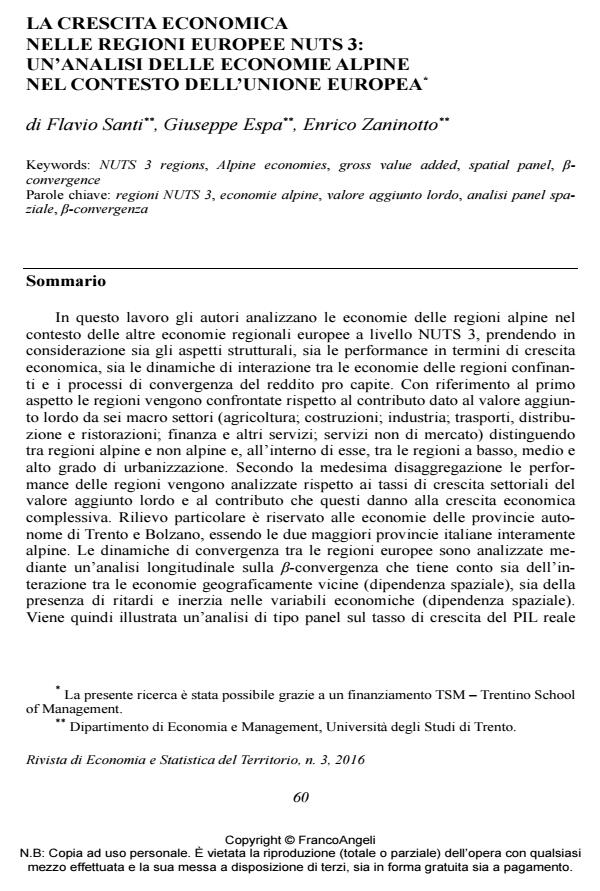The Economic Growth in European NUTS 3 regions: an investigation on Alpine regions in the context of European Union
Journal title RIVISTA DI ECONOMIA E STATISTICA DEL TERRITORIO
Author/s Flavio Santi, Giuseppe Espa, Enrico Zaninotto
Publishing Year 2017 Issue 2016/3
Language Italian Pages 29 P. 60-88 File size 3072 KB
DOI 10.3280/REST2016-003005
DOI is like a bar code for intellectual property: to have more infomation
click here
Below, you can see the article first page
If you want to buy this article in PDF format, you can do it, following the instructions to buy download credits

FrancoAngeli is member of Publishers International Linking Association, Inc (PILA), a not-for-profit association which run the CrossRef service enabling links to and from online scholarly content.
The present paper aims at providing an analysis on the economies of European NUTS 3 regions and, in particular, of Alpine NUTS 3 regions. The aim of the analysis is to verify whether there are differences in the structure and in the performance of Alpine and non-Alpine regions, and to study the convergence dynamics of European NUTS 3 regions.
Methods and Results
The structure of the regional economies and their performance are analysed according to the contribution of six macro-sectors (agriculture; constructions; manufacturing; transport, distribution, hotel and restaurants; finance and service industry; non-market services) to the regional gross value added (GVA) and to the regional GVA growth rate respectively. Alpine and non-Alpine regions are compared according to their degree of urbanisation and their level of per capita GDP. The convergence of regional NUTS 3 economies is studied by means of a panel on 1186 regions between 2003 and 2012 which allows for both spatial effects on the dependent variable and serial autocorrelation in the error term. This permits to model and evaluate the role that interaction between neighbouring economies has on the convergence process of per capita GDP. The degree of interdependence amongst neighbouring regions is analysed in order to delimit geographically the area of influence of the economies of the Alpine area.
Conclusions
The results show that the economies of NUTS 3 Alpine regions are markedly different from other regions both in terms of structure and performances. The estimates suggest that on average NUTS 3 economies tend to converge in terms of per capita GDP. Moreover, the process is stimulated and accelerated by the interdependence amongst neighbouring regions.
Keywords: NUTS 3 regions, Alpine economies, gross value added, spatial panel, β-convergence
Jel codes: O47; R10; R11; R12
- Arbia G., Basile R., Piras G. (2005), Using Spatial Panel Data in Modelling Regional Growth and Convergence, ISAE Working Paper, 55.
- Barro R.J., Sala-i-Martin X. (1995), Economic Growth. New York: McGraw Hill.
- LeSage J.P., Pace R.K. (2009), Introduction to Spatial Econometrics. Boca Raton (FL): Chapmann & Hall.
- Solow R.M. (1956), A Contribution to the Theory of Economic Growth, The Quarterly Journal of economics, 70, pp. 65-94.
- Swan T.W. (1956), Economic Growth and Capital Accumulation, Economic Record, 3, pp. 334-361.
Flavio Santi, Giuseppe Espa, Enrico Zaninotto, La crescita economica nelle regioni europee nuts 3: un’analisi delle economie alpine nel contesto dell’unione europea in "RIVISTA DI ECONOMIA E STATISTICA DEL TERRITORIO" 3/2016, pp 60-88, DOI: 10.3280/REST2016-003005